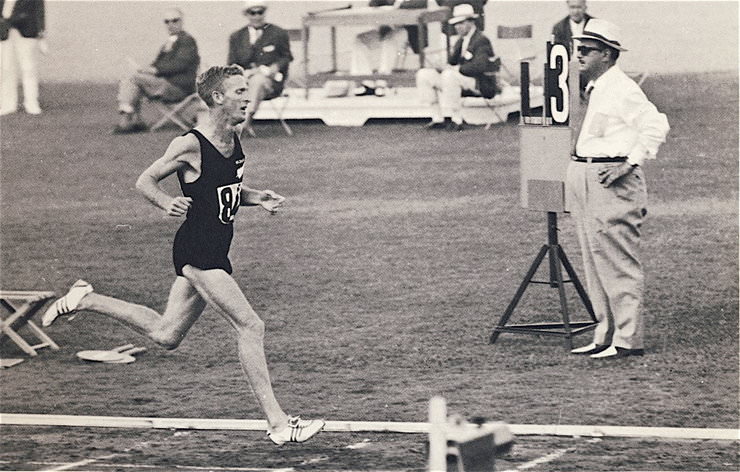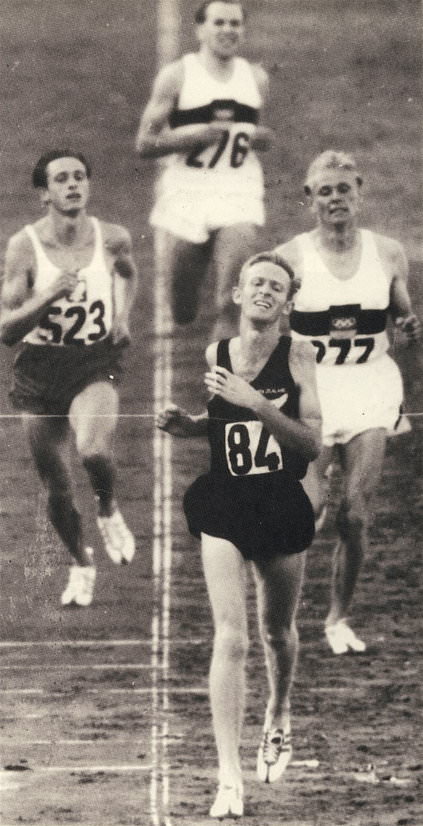Halberg v Grodotzki v Zimny
1960 Olympic Games 5,000 Rome
Great Races #14
If Elliott’s victory in the 1,500 was the most dominant track performance of the Rome Olympics, Murray Halberg’s was the most courageous. To inject a 61.1 tenth lap in a 5,000 meant that he had exposed himself completely. He had planned with his coach Arthur Lydiard to carry out this daring strategy: “Towards the end of the race he would launch himself into a breakneck speed for a whole lap. He would hold this speed for as long as possible. It would gradually and inevitably fade until he and the whole field were drained of all their speed. They would then have to run the last lap in a state of utter exhaustion, on rubber legs, gasping for breath.” (Norman Harris, Lap of Honour, p. 111) Although certainly not the most talented runner in the field, Halberg was the most determined to win. And he did.
 |
| Halberg makes his move with three laps to go. |
The heats eliminated some runners thought to have a medal chance: Gordon Pirie and Bruce Tulloh of Britain, Boris Yefimov of the USSR, and Miroslav Jurek of Czechoslovakia. On the other hand, Dave Power of Australia and Kiwi Halberg looked good in the heats. Also fancied were Poland’s Kazimierz Zimny, and two Germans, Hans Grodotzki and Friedrich Janke, who had both won their heats.
The field of 12 for the final stayed together for seven laps. Zimny did most of the leading through 62, 2:08, 3:15, 4:20, 5:28, 6:38 and 7:45. After the fast first lap, this pace varied between 65 and 70. It was in the seventh lap that things started to happen. Grodotzki moved up from the back and Halberg shadowed him. Still, the eighth lap was a slowish 69. Then Dave Power really stirred up the race as he roared into the lead at 8 1/2 laps. Surprisingly he soon eased up and allowed himself to be caught by the pack, which was now reduced to seven by the faster 66-second ninth lap.
 |
| Halberg hits the tape, whileGrodotzki just holds off Zimny. |
Just when the pack relaxed after catching Power, Halberg took the initiative, moving discreetly past Grodotzki and Zimny, and then finally sprinting past Power—with three laps to go. It was a bold move that looked suicidal to the spectators and, I suspect, to the competitors, none of whom reacted at all. Halberg wrote in his autobiography: “I improved my place to second in the field. I settled there momentarily, gathered my strength. Then with all I had, I sprinted.” (CleanPair of Heels, p.105) The crowd roared in appreciation as Halberg quickly opened up a 12-meter gap. With 2 1/2 laps to go, Halberg was 20 meters ahead; he had run a 61 lap, with most of the speed coming in the second half. Grodotzki was the only one to react at all to this breakaway.
Halberg maintained his 20-meter lead on the next lap (64), while Grodotzki had moved 20 meters ahead of Janke. Although Halberg’s pace dropped to 34 in the next 200, he was still 15 meters up on Grodotzki at the bell. Both the leading pair were hurting by now and the field was closing on them. With 200 to go, Halberg still had 12 meters on Grodotzki, but Janke and Zimny were closing fast. Halberg’s concern was clear to everyone, as he kept glancing back.
There was some desperate hanging on in the final straight. Halberg held on for an 8-meter victory, while Grodotzki barely held off Zimny for second. Four of the top six ran PBs: Halberg, Grodotzki, Power and Nyandika. Halberg’s time put him in fifth on the all-time list. But this was not a race for fast times; it was a race where a courageous runner put everything on the line to win.
1. Murray Halberg NZL 13:43.4; 2. Hans Grodotzki GER 13:44.6; 3. Kazimierz Zimny POL 14:44.8; 4. Friedrich Janke GER 13:46.8; 5. Dave Power 13:51.8; 6. Maiyoro Nyandika KEN 13:52.8. 
Leave a Comment